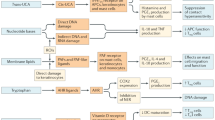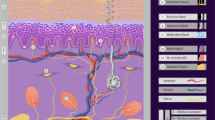Abstract
SINCE the fundamental experiments of Hausser and Vahle1, in 1922, it has been known that two wavelength regions of the ultra-violet spectrum, namely, near 297 mµ and about 250 mµ, have maximum efficiency in producing erythema in human skin. These regions are separated by a region near 280 mµ with small erythemal activity. The explanation for this action spectrum has been sought in the screening function of the superficially situated horny layer which, as a protein with aromatic compounds, has a maximum light absorption2 near 280 mµ
This is a preview of subscription content, access via your institution
Access options
Subscribe to this journal
Receive 51 print issues and online access
$199.00 per year
only $3.90 per issue
Buy this article
- Purchase on Springer Link
- Instant access to full article PDF
Prices may be subject to local taxes which are calculated during checkout
Similar content being viewed by others
References
Hausser, K. W., and Vahle, W., Strahlentherapie, 13, 41 (1922). Bachem, A., Strahlentherapie, 39, 30 (1931). Lucas, N. S., Biochem. J., 25, 57 (1931). Miescher, G., Stahlentherapie, 35, 403 (1930). Mitchell, J. S., Proc. Roy. Soc., B, 126, 241 (1939).
Rottier, P. B., Séméiologie et Thérapeutique, 21, 14 (1951).
Author information
Authors and Affiliations
Rights and permissions
About this article
Cite this article
ROTTIER, P., MULLINK, J. Localization of Erythemal Processes caused by Ultra-Violet Light in Human Skin. Nature 170, 574–575 (1952). https://doi.org/10.1038/170574a0
Issue Date:
DOI: https://doi.org/10.1038/170574a0
This article is cited by
-
Human skin pigmentation, its genetics and variation
Humangenetik (1974)
-
Parent-child relationship and sex differences in skin tanning potential in man
Human Genetics (1972)
-
Was ist ?die Rottiersche Theorie �ber das UV-Erythem bei 250 nm??
Archiv f�r Klinische und Experimentelle Dermatologie (1970)
-
Genetical differences in skin tanning capacity
Genetica (1969)
-
Urinary Excretion Pattern of Serotonin and 5-Hydroxyindole Acetic Acid in Ultraviolet Induced Erythema**From the Institute of Radiopathology, University of Groningen, Groningen, The Netherlands.
Journal of Investigative Dermatology (1968)
Comments
By submitting a comment you agree to abide by our Terms and Community Guidelines. If you find something abusive or that does not comply with our terms or guidelines please flag it as inappropriate.



